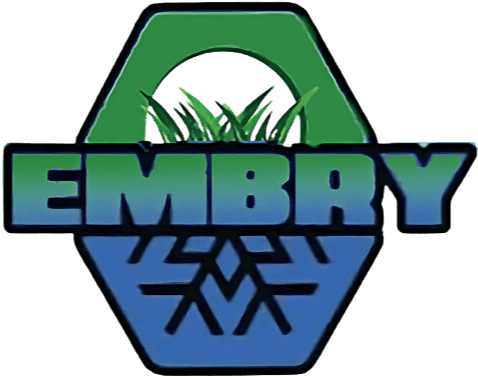Common Lawn Pests: How to Deal With Them
Posted on April 1st, 2024
Maintaining a healthy lawn is a top priority for homeowners, but it can be challenging when pests invade. At Embry Lawn & Snow Services, LLC, we understand the importance of keeping your lawn free from pests. In this blog post, we'll discuss some common lawn pests and provide tips on how to deal with them effectively.
Grubs
Identification: Grubs are the larvae of beetles, such as Japanese beetles and chafers. They are white, C-shaped, and feed on grass roots, causing brown patches in your lawn.
Prevention: Maintaining a healthy lawn through proper watering, mowing, and fertilization can make it less attractive to beetles looking to lay eggs. Applying nematodes, which are natural predators of grubs, can also help control their population.
Treatment: If grubs are already present, treatments include applying grub-specific insecticides or encouraging natural predators like birds and beneficial insects to visit your lawn. It's important to apply treatments in late summer or early fall, when grubs are most active for the best results.
Chinch Bugs
Identification: Chinch bugs are small, black insects with white wings. They suck the sap from grass, causing yellow patches that turn brown and die.
Prevention: Proper lawn maintenance, including aeration and dethatching, can reduce the likelihood of chinch bug infestations. Watering your lawn deeply but infrequently, can also help.
Treatment: Insecticidal soap or pyrethrin-based insecticides can be effective in controlling chinch bugs. It's important to apply these treatments when the bugs are active for the best results. Regular monitoring of your lawn for signs of chinch bug activity can help catch infestations early.
Armyworms
Identification: Armyworms are caterpillars that feed on grass blades, leaving behind bare patches. They are most active in the early morning or late evening.
Prevention: Regularly inspecting your lawn for signs of armyworms and maintaining a healthy lawn can help prevent infestations. Encouraging natural predators, such as birds, can also help keep armyworm populations in check.
Treatment: If you notice armyworms, applying a suitable insecticide can help control their population. It's crucial to follow the product instructions carefully to ensure effectiveness and safety. Reapplying the treatment may be necessary if the infestation is severe.
Sod Webworms
Identification: Sod webworms are small, white caterpillars that feed on grass at night, creating brown patches in the lawn.
Prevention: Encouraging natural predators, such as birds, can help keep sod webworm populations in check. Regular lawn care practices also play a role in prevention, as a healthy lawn is less susceptible to infestations.
Treatment: Insecticides targeting caterpillars can be effective against sod webworms. Applying these treatments in the evening, when the pests are most active, can improve their effectiveness. Be sure to treat the entire affected area to ensure complete control of the infestation.
Billbugs
Identification: Billbugs are weevils that lay eggs in the grass, and their larvae feed on the stems, causing yellow patches that eventually turn brown.
Prevention: A healthy lawn is less susceptible to billbug infestations. Regular monitoring for signs of damage can help catch problems early. Proper lawn care practices, such as appropriate watering and fertilization, can also help prevent billbug infestations.
Treatment: If billbugs are present, insecticides can be applied to control the larvae. It's important to target the treatment to the affected areas to minimize environmental impact. Repeated applications may be necessary for severe infestations.
Mole Crickets
Identification: Mole crickets are large insects that burrow through the soil, damaging grass roots and creating tunnels that can ruin the lawn's appearance.
Prevention: Reducing excessive moisture in your lawn can make it less attractive to mole crickets. Proper lawn care practices, such as regular mowing and aeration, also help reduce the likelihood of mole cricket infestations.
Treatment: Bait or insecticides specifically designed for mole crickets can be effective in controlling their population. Applying these treatments in the early evening, when the crickets are most active, can improve their effectiveness. Regular monitoring of your lawn for signs of mole cricket activity can help catch infestations early.
Fire Ants
Identification: Fire ants build large mounds in the lawn and can deliver painful stings. Their presence can make outdoor areas unsafe.
Prevention: Keeping your lawn healthy and monitoring for signs of fire ant activity can help prevent infestations. Regularly inspecting your lawn for new mounds and treating them promptly can help keep fire ant populations under control.
Treatment: Fire ant baits and insecticides can be used to control their population. It's important to treat the entire area to ensure all colonies are eliminated. Follow-up treatments may be necessary to maintain control of fire ant populations.
Aphids
Identification: Aphids are small, soft-bodied insects that feed on plant sap, causing yellowing and distortion of grass blades.
Prevention: Encouraging natural predators, such as ladybugs, can help control aphid populations. Healthy lawn care practices also reduce the likelihood of infestations, as a well-maintained lawn is more resistant to pests.
Treatment: Insecticidal soaps or neem oil can be effective in controlling aphids. These treatments are best applied when aphids are first noticed to prevent further damage. Regular monitoring of your lawn for signs of aphids can help catch infestations early.
Conclusion
Dealing with lawn pests can be challenging, but with the right knowledge and tools, you can keep your lawn healthy and pest-free. At Embry Lawn & Snow Services, LLC, we're dedicated to providing effective lawn care and snow removal services to the Sedalia community. If you're experiencing issues with lawn pests or need assistance with lawn maintenance, don't hesitate to reach out to us at (660) 221-4448 or [email protected]. Our team is here to help you achieve a beautiful and healthy lawn.
Reach Out for Personalized Lawn Solutions
We're here to help you achieve a beautiful and healthy outdoor space. Please fill out the form below with your details and any specific services you're interested in.
